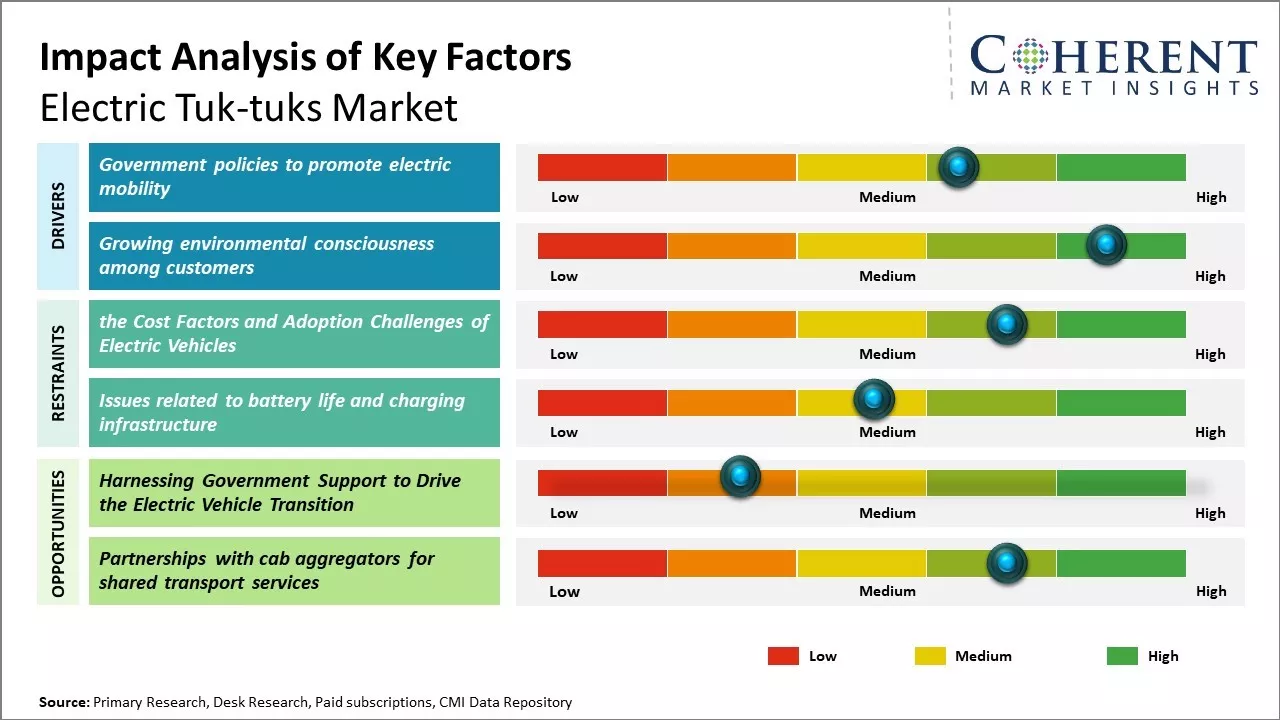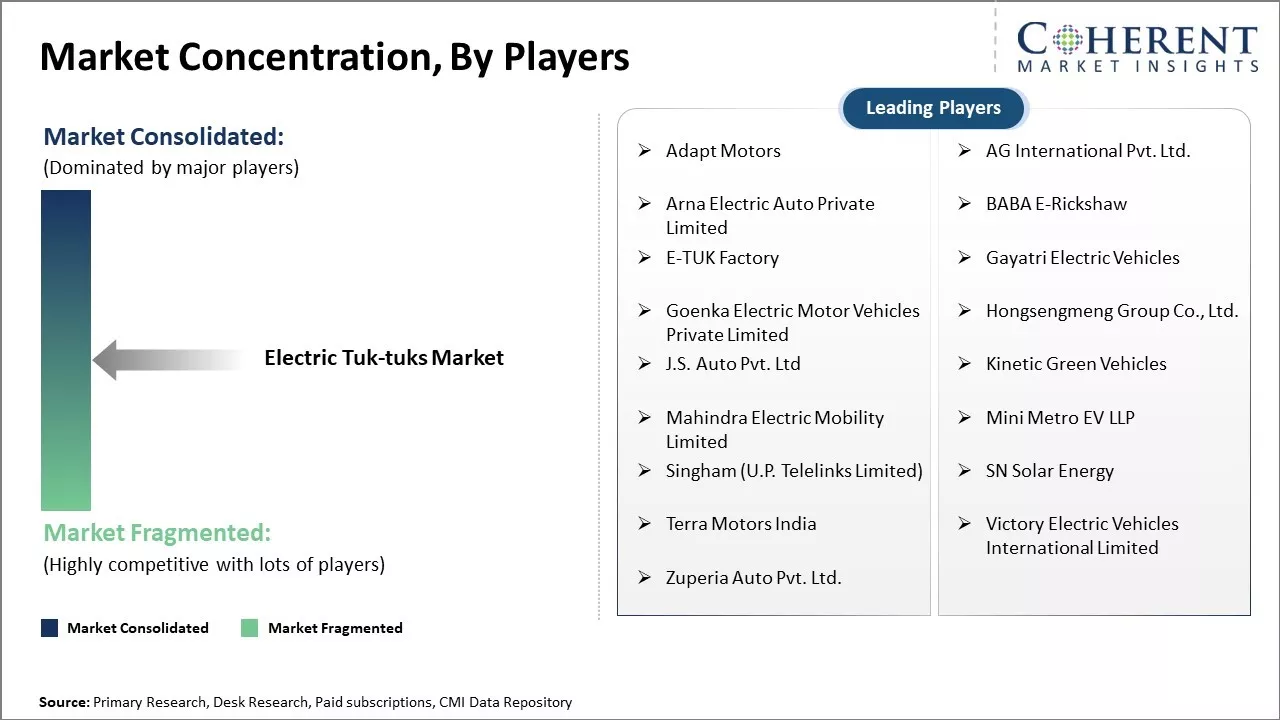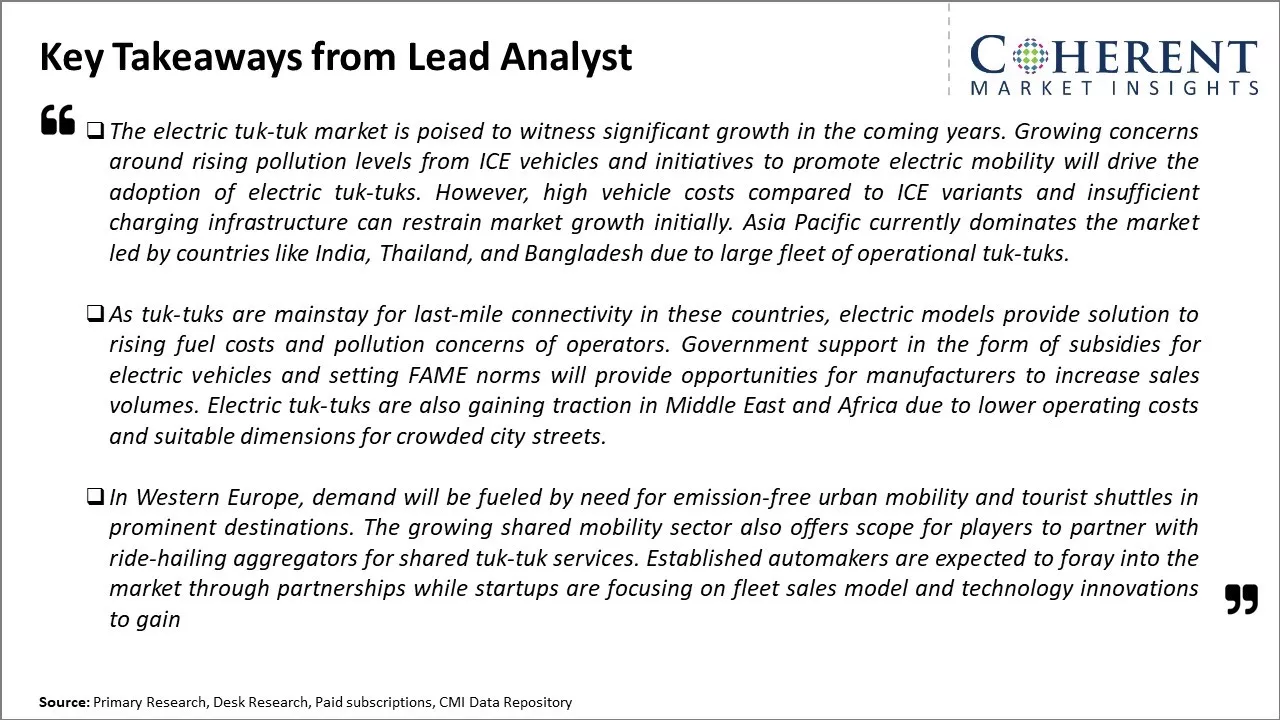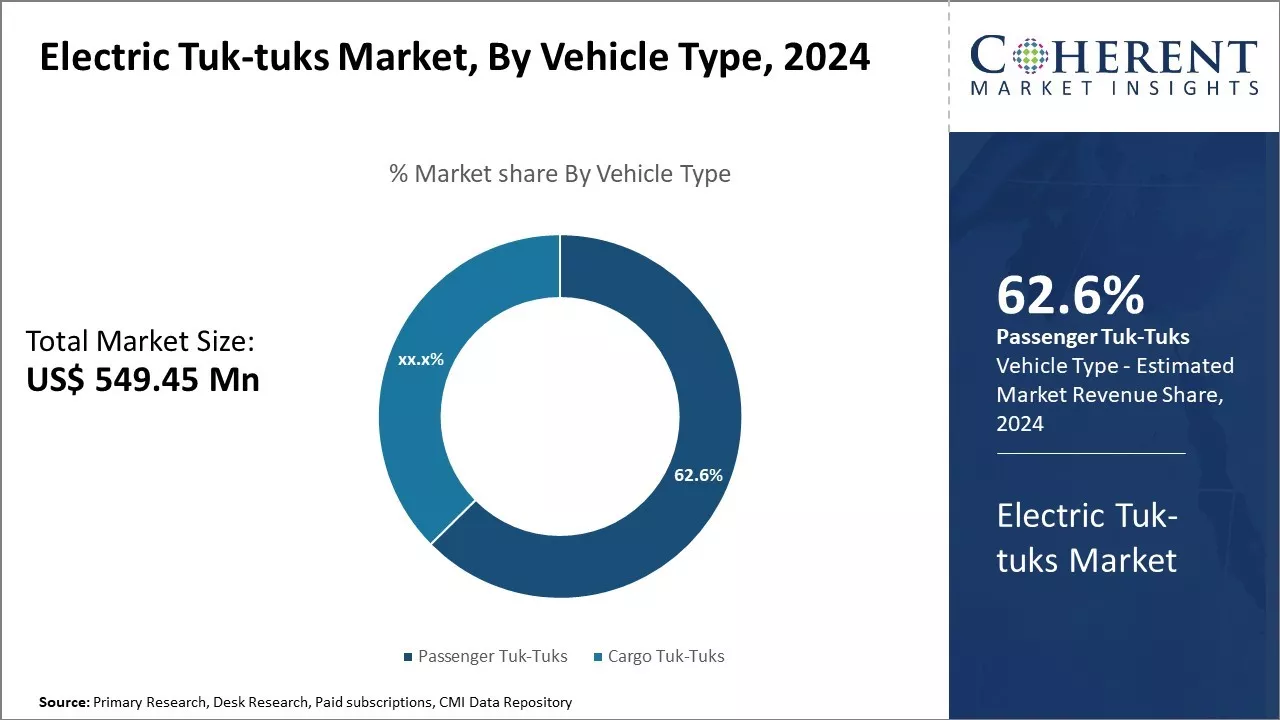Global electric tuk-tuks market is estimated to be valued at US$ 585.2 Mn in 2025 and is expected to reach US$ 910.0 Mn by 2032, exhibiting a compound annual growth rate (CAGR) of 6.5% from 2025 to 2032.

Discover market dynamics shaping the industry: Request sample copy
The market is witnessing high growth due to rising adoption of electric vehicles for public transportation across countries to reduce carbon emissions. Countries in South Asia and Southeast Asia are focusing on replacing existing fossil fuel three-wheelers with electric tuk-tuks to improve air quality. Growing investments by governments and OEMs in charging infrastructure development are encouraging the transition to environment-friendly electric tuk-tuks. However, the availability of low-cost fossil fuel alternatives and lack of standardization in charging solutions can hamper the market growth.
Government policies to promote electric mobility
Many governments are taking initiatives to switch commuting from petrol or diesel vehicles to more sustainable electric vehicles. These are pushing adoption of electric vehicles through various policies and schemes. For instance, some countries offer purchase incentives on electric Tuk-Tuks to encourage drivers to go electric. The incentives can make electric tuk-tuks a more affordable option as compared to internal combustion engine models. Some nations also provide subsidies on purchasing charging infrastructure for owners of electric tuk-tuks. This helps address range anxiety among drivers and boosts the adoption of electric variants.
Many cities and local authorities in Asia Pacific are also formulating policies to restrict or ban conventionally-fueled tuk-tuks in the near future. These want to lower air pollution levels and carbon emissions from transport sector. Some major cities have announced that it will allow registration of only electric tuk-tuks from a certain future date. While this puts pressure on the existing drivers, it also creates a huge business prospect for electric tuk-tuks. Manufacturers are aiming to cater to this impending demand. The governments are also coming up with specific schemes to reskill drivers of traditional Tuk-Tuks so that these can smoothly switch to electric vehicles. With supportive regulations, a controlled transition seems possible which will accelerate the electric tuk-tuks market growth.

Get actionable strategies to beat competition: Request sample copy
Market Driver: Growing environmental consciousness among customersDue to rising environmental pollution levels and frequent reports of adverse impacts of climate change, people are becoming more aware of their carbon footprint. Many customers now prefer choosing electric vehicles and eco-friendly transportation options for their daily commuting as well as tour and travel purposes. Even in economies where disposable incomes are increasing, a significant section of urban population is willing to pay a slight premium for electric vehicles just for their green and sustainable credentials. This consumer preference for low emission vehicles is benefiting the electric tuk-tuks market.
Moreover, electric vehicles are now seen as a status symbol and representation of modern lifestyles. Young and environmentally-conscious masses find electric vehicles appealing. As tuk-tuks are commonly used as hired vehicles, In cities where pollution is a big problem, both tourists and business travelers prefer clean electric options. This good image helps electric Tuk-Tuk manufacturers with their branding and marketing efforts. It allows them to promote their vehicles as a sustainable choice preserving local environments.

To learn more about this report, Request sample copy
Market Challenges: Cost Factors and Adoption Challenges of Electric VehiclesHigher upfront costs of electric vehicles as compared to traditional gasoline or diesel models can hamper the market growth. The battery packs required significantly increase pricing. There are also issues with lack of charging infrastructure in many areas. This limited range associated with most electric tuk-tuks hampers their adoption. Another barrier is lack of awareness among customers. Many are unfamiliar with the benefits of switching to eco-friendly electric modes of transport.
Market Opportunities: Harnessing Government Support to Drive the Electric Vehicle Transition
Government support through purchase subsidies and investments in public charging stations can accelerate the transition to electric. Many nations are offering incentives to switch commercial fleets to electric to reduce toxic emissions. As battery technology improves continually, range will increase and costs will decline gradually. This will make electric tuk-tuks a more commercially viable proposition.

Discover high revenue pocket segments and roadmap to it: Request sample copy
Insights, By Vehicle Type- Growing Demand for Eco-friendly Mobility SolutionsIn terms of vehicle type, passenger tuk-tuks segment is estimated to contribute the highest market share of 63.1% market share in 2025, due to growing demand for affordable and eco-friendly city transportation options. Passenger tuk-tuks are gaining popularity due to their small size and ability to maneuver through heavy traffic and narrow streets. These provide an inexpensive means of transportation for short commutes within city limits. Rising awareness about environmental impact of fossil fuel-based vehicles is encouraging many consumers to switch to electric passenger tuk-tuks. Their zero-emission and low maintenance nature makes them a sustainable alternative to auto rickshaws and taxi cabs in congested urban areas. Various government initiatives offering subsidies and tax rebates on electric passenger vehicles can drive the segment growth.
Insights, By Power Type- Balanced Performance Needs For Commercial Applications
In terms of power type, the 1,000W to 1,500W segment is estimated to contribute the highest market share of 56.3% in 2025 as it offers a balanced performance meeting the requirements of light commercial applications. Cargo tuk-tuks demand a motor powerful enough to carry goods but not overly large to affect maneuverability. Tuk-tuks of power rating between 1,000W to 1,500W provides sufficient torque for transportation of parcels and retail items within a paylaod capacity of 150-250kg. It allows cargo tuk-tuks to cover intra-city distances of 50-80km on a single charge based on average load. This power range strikes the right balance between performance, payload capability and battery life important for last-mile logistic needs of retailers and deliveries.
Insights, By Battery Type -Long Battery Life Requirements for Commercial and Passenger Transport
In terms of battery type, lithium-ion segment is estimated to contribute the highest market share of 67.6% in 2025 as it meets the long-life demands of commercial and passenger transport applications. Being a rechargeable battery, lithium-ion offers high energy density to provide longer running range in comparison to lead-acid batteries. Its lightweight and compact size also contributes to greater usable cabin space. Lithium-ion batteries retain a high percentage of their original capacity even after extensive charge-discharge cycles, delivering years of effective service life. This directly reduce operations and maintenance costs for fleet owners. With technology advancements, lithium-ion batteries are becoming safer and more affordable, thus, making them a preferred choice for commercial electric vehicles.

Need a Different Region or Segment? Customize now
Asia Pacific has firmly established itself as the dominant region in the global electric tuk-tuks market with estimated 69.8% market share in 2025 due to strong industry presence and government support. Countries like India, Bangladesh and Sri Lanka have a long history of using combustion engine-powered tuk-tuks for last mile transportation, logistics and cargo purposes. With rising pollution levels in urban centers, these countries are actively promoting adoption of electric vehicles. India, in particular, has launched large incentive schemes and infrastructure development programs to transition its fleet of over a million gasoline and diesel tuk-tuks to cleaner electric models. Several large domestic manufacturers have set up dedicated electric tuk-tuks production facilities in the country to tap into this growing demand. The supportive policy regime coupled with availability of affordable financing options has made electric tuk-tuks the primary choice for both fleet operators as well as individual owners in South Asia.
Southeast Asia is emerging as the fastest growing regional market for electric tuk-tuks globally. Countries like Thailand, Vietnam and Indonesia are experiencing strong economic growth which has led to rapid urbanization and increased demand for affordable last mile transportation options. As local municipalities grapple with traffic congestion and air quality issues, these are promoting electric vehicles including tuk-tuks through taxation benefits and subsidies. Vietnamese cities in particular haswitnessed a surge in electric tuk-tuks plying on roads in the last year. The presence of established combustion engine tuk-tuk manufacturing clusters and availability of low-cost labor provides a conductive manufacturing base for electric variants. Thai manufacturers have leveraged their design and engineering expertise to mass produce affordable lithium-ion battery packs and electric motors for the local and export market. This has made Southeast Asia an important hub for electric tuk-tuk imports into newer markets as well.
Electric Tuk-tuks Market Report Coverage
| Report Coverage | Details | ||
|---|---|---|---|
| Base Year: | 2024 | Market Size in 2025: | USD 585.2 Mn |
| Historical Data for: | 2020 To 2024 | Forecast Period: | 2025 To 2032 |
| Forecast Period 2025 to 2032 CAGR: | 6.5% | 2032 Value Projection: | USD 910.0 Mn |
| Geographies covered: |
|
||
| Segments covered: |
|
||
| Companies covered: |
Adapt Motors, AG International Pvt. Ltd., Arna Electric Auto Private Limited, BABA E-Rickshaw, E-TUK Factory, Gayatri Electric Vehicles, Goenka Electric Motor Vehicles Private Limited, Hongsengmeng Group Co., Ltd., J.S. Auto Pvt. Ltd, Kinetic Green Vehicles, Mahindra Electric Mobility Limited, Mini Metro EV LLP, Singham (U.P. Telelinks Limited), SN Solar Energy, Terra Motors India, Victory Electric Vehicles International Limited, Zuperia Auto Pvt. Ltd. |
||
| Growth Drivers: |
|
||
| Restraints & Challenges: |
|
||
Uncover macros and micros vetted on 75+ parameters: Get instant access to report
Share
Share
About Author
Ameya Thakkar is a seasoned management consultant with 9+ years of experience optimizing operations and driving growth for companies in the automotive and transportation sector. As a senior consultant at CMI, Ameya has led strategic initiatives that have delivered over $50M in cost savings and revenue gains for clients. Ameya specializes in supply chain optimization, process re-engineering, and identification of deep revenue pockets. He has deep expertise in the automotive industry, having worked with major OEMs and suppliers on complex challenges such as supplier analysis, demand analysis, competitive analysis, and Industry 4.0 implementation.
Missing comfort of reading report in your local language? Find your preferred language :
Transform your Strategy with Exclusive Trending Reports :
Frequently Asked Questions
Joining thousands of companies around the world committed to making the Excellent Business Solutions.
View All Our Clients
US Reciprocal Tax Impact Analysis On Global Electric Tuk-tuks Market
Stay updated on tariff changes with expert insights and timely information